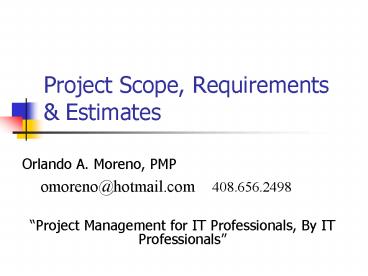Project Scope, Requirements - PowerPoint PPT Presentation
Title:
Project Scope, Requirements
Description:
Requirements & Tools. Estimates. 408.656.2498. omoreno_at_hotmail.com ... Is this a business problem or just a cool technical solution? Is the objective realistic? ... – PowerPoint PPT presentation
Number of Views:57
Avg rating:3.0/5.0
Title: Project Scope, Requirements
1
Project Scope, Requirements Estimates
- Orlando A. Moreno, PMP
- omoreno_at_hotmail.com 408.656.2498
- Project Management for IT Professionals, By IT
Professionals
2
Agenda
- What Are The Facts
- Project Scope
- Requirements Tools
- Estimates
3
What Are The Facts
- In 1994 only 16 of software projects were deemed
successful - In 2002 28 of software projects were deemed
successful - 2 of IT professionals have their PMP
- 34 have no need for the PMP
- 16 of IT projects finish on time budget.
- 94 of IT project have at least one restart.
- The average IT budget ends up being 188 of plan.
- The average IT delivery time is 222 of original
forecast. - Only 61 of IT projects maintain their original
scope. - 30 of all projects are cancelled.
- 70 of all projects fail to deliver expected
features
4
What Are The Facts
- PMI estimates the size of the PM profession
globally at 16 million. - 4.5 million people involved in PM within the U.S.
- Nearly 25 of the worlds GDP is spent on
projects. - 10 trillion spent worldwide on projects
annually. - The average U.S. project management initiative
costs approximately 570,000 - 43.3 of all statistics are meaningless
5
What Are The Facts
- Based on your personal experiences and readings
of projects, what makes a project a success or
failure?
6
What Are The Facts
- Why Are Good Requirements And Scope Definition So
Important?
- Approximately 56of software defects can be
traced to scope/requirements-related issues. - Approximately82of the effort required to fix
bugs can be traced to scope/requirements-related
issues.
7
Scope
8
Scope
- Scope Management includes the processes required
to ensure that the project includes all the work
required, and only the work required, to complete
the project successfully.
9
Scope
Scope Covers Two Key Points -Vision
-Expectations
10
Scope
- Keys To Quality Scope Definition
- What are you trying to do why?
- Is this a business problem or just a cool
technical solution? - Is the objective realistic?
- What are the constraints assumptions?
- Does your team believe in it?
- Do you have clear executive support?
- What does your communication look like?
11
Requirements
12
Requirements
Requirements specify exactly what the product or
service of the project will do, how it will do
it, and any assumptions or constraints with which
it must work.
13
Requirements
- Common Excuses
- We must start producing today
- Developing a product or service without clear
requirements guarantees rework. - Too much specificity stifles creativity.
- You want creativity in achieving objectives not
defining them. - Your project entails R D, and you cant tell
today what needs to be accomplished. - In these projects it is even more important that
you clearly define what you want to achieve. - What if interests or needs change?
- Objectives are targets based on what you know
today. If things change revisit your objectives.
14
Requirements
- Getting Quality Requirements
- Process Diagramming
- Displayed Thinking
- The Work Breakdown Structure
- Avoid the MS Project Task Disaster.
- Answer the question, how will I know when this
need is met? - Which model are you using????
15
Requirements
- Tips
- Check for hidden inferences.
- Use words that clearly describe intended
activities. For example implementation or
deployment are words often used that are not
clear. - Confirm your understanding with the key
stakeholders. - Make your objectives controllable. If you cant
influence whether you achieve them you shouldnt
use them. - Identify all your objectives, and only work to
achieve defined objectives. - Be sure your sponsor and stakeholders agree with
your objectives.
16
Estimates
17
Estimates
- How do you get your estimates?
- A) I use a crystal ball.
- B) My team comes up with them.
- C) I ask subject matter experts.
- D) They are given to me by the project sponsor.
- E) I use numbers from previous projects.
18
Estimates
- How often do your estimates reflect reality?
- A) Always
- B) Often
- C) Sometimes
- D) Occasionally
- E) Never
19
Estimates
- Getting Quality Estimates
- Ask subject matter experts for most likely WORK.
- Change your software to calculate DURATION.
- Confirm this duration with your expert as a
reasonable most-likely estimate. - Collect a worst best case estimate use PERT.
- Continually compare estimates to actual results.
- Maintain historical data.
20
Estimates
- Program Evaluation Review Technique (PERT)
PERT Weighted Average
Optimistic 4X Most Likely Pessimistic 6
PERT Standard Deviation
Pessimistic - Optimistic 6
21
The Project Managers Success Strategy
22
Projects Are Like Golf
- Golf Projects are like raising children You
keep thinking you will do better next time - Orlando A. Moreno, PMP
- omoreno_at_hotmail.com 408.656.2498
- Project Management Training Consulting































